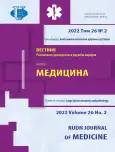Immune reactivity features in post-burn dynamics
- 作者: Azhikova A.K.1, Yasenyavskaya A.L.1, Samotrueva M.A.1
-
隶属关系:
- Astrakhan State Medical University
- 期: 卷 26, 编号 2 (2022): LARGE JOINTS ANATOMY AND PATHOLOGY
- 页面: 194-202
- 栏目: DERMATOLOGY
- URL: https://journal-vniispk.ru/2313-0245/article/view/319642
- DOI: https://doi.org/10.22363/2313-0245-2022-26-2-194-202
- ID: 319642
如何引用文章
全文:
详细
Relevance. To date, burn injury remains a complex type of damage to skin tissues. Along with local destructive and dystrophic phenomena, systemic changes in the body are observed. The aim of the study was the experimental study of the immune reactivity of the body of nonlinear rats under conditions of “burn” stress formed as a result of contact thermal trauma. Materials and Methods. The study was carried out on non-linear male rats with an average mass of 220 gr. The functional activity of the immune system of laboratory animals was evaluated on the basis of standard tests assessing the adaptability of the immune system. Results and Discussion. In an experimental study, it was found that in the dynamics of burn injury in laboratory animals, variable changes in the body’s immune reactivity were observed at the level of the cellular and humoral links of immunity, which was manifested by a decrease in the WGST index and an increase in the following indicators - antibody titer, phagocytic index (FI), phagocytic number (FF), leukocytic coefficient and number of leukocytes. The increased content of stick-n uclear forms indicated the activation of granulocytopoiesis, which determined the deregenerative nuclear shift of neutrophil granulocytes to the left. Along with these changes, a decrease in the mass of immune organs (thymus and spleen) was observed, which can be explained by the expression of accidental involution caused by intoxication against the background of a thermal burn. Conclusion. Under conditions of “burn” stress, an immune imbalance occurs in the form of activation of some and suppression of other links at different observation times. Thus, during the burn process, systemic immune changes taking place at the body level have a multi-d irectional dynamic character, which indicates the adaptive capabilities of the immune system.
作者简介
Alfiya Azhikova
Astrakhan State Medical University
Email: alfiaimacheva@mail.ru
ORCID iD: 0000-0001-9758-1638
Astrakhan, Russian Federation
A. Yasenyavskaya
Astrakhan State Medical University
Email: alfiaimacheva@mail.ru
ORCID iD: 0000-0003-2998-2864
Astrakhan, Russian Federation
M. Samotrueva
Astrakhan State Medical University
编辑信件的主要联系方式.
Email: alfiaimacheva@mail.ru
ORCID iD: 0000-0001-5336-4455
Astrakhan, Russian Federation
参考
- Makhneva NV. Cellular and humoral components of the skin immune system. Russian magazine of skin and venereal diseases. 2016;19(1):12—17 (in Russian).
- Belokhvostova D, Berzanskyte I, Cujba AM, Jowett G, Marshall L, Prueller J, Watt FM. Homeostasis, regeneration and tumour formation in the mammalian epidermis. Int J. Dev Biol. 2018;62(6—7—8):571—582.
- Voisin T, Bouvier A, Chiu IM. Neuro-immune interactions in allergic diseases: novel targets for therapeutics. Int Immunol. 2017;29(6):247—261. doi: https://doi: 10.1093/intimm/dxx040.
- Khaitov RM. Immunology: structure and function of immune system. Textbook. 2nd, renewed. M.: GEOTAR-Media, 2019. 328 p. (in Russian).
- Samotrueva MA, Yasenyavskaya AL, Tsibizova АA, Bashkina OA, Galimzyanov Kh M. Neuroimmunoendocrinology: modern concepts of molecular mechanisms. Immunologiya. 2017;38(1):49—59. doi: https://doi: 10.18821/0206-4952-2017-38-1-49-59 (in Russian).
- Kon’kov SV, Ilyukevich GV, Zolotukhina LV. Evaluation of the effectiveness of the immunocorrection method in patients with severe thermal trauma. Emergency medicine. 2016;5(1):72—79 (in Russian).
- Korneva EA, Shanin SN, Novikova NS, Pugach VA. Cellmolecular bases of neuroimmune interaction under stress. Russian physiological journal named after I.M. Sechenov. 2017;103(3):217—229 (in Russian).
- Morrison VV, Bozhedomov AYu, Simonyan MA, Morrison AV. Systemic inflammatory response and cytokine profile in the dynamics of burn disease. Saratov Scientific and Medical Journal. 2017;13(2):229—232 (in Russian).
- Veiga-F ernandes H, Mucida D. Neuro-I mmune Interactions at Barrier Surfaces. Cell. 2016;165(4):801811. 10.1016/j' target='_blank'>https://doi: 10.1016/j. cell.2016.04.041.
- Vinaik R, Abdullahi A, Barayan D, Jeschke MG. NLRP3 inflammasome activity is required for wound healing after burns. Transl Res. 2020;217:47—60. doi: 10.1016/j.trsl.2019.11.002
- Abo El-N oor MM, Elgazzar FM, Alshenawy HA. Role of inducible nitric oxide synthase and interleukin-6 expression in estimation of skin burn age and vitality. J Forensic Leg Med. 2017;52:148—153. 10.1016/j.jflm.2017.09.001' target='_blank'>https://doi: 10.1016/j.jflm.2017.09.001
- Oka T, Ohta K, Kanazawa T, Nakamura K. Interaction between Macrophages and Fibroblasts during Wound Healing of Burn Injuries in Rats. Kurume Med J. 2016;62(3—4):59—66.https:// doi: 10.2739/kurumemedj.MS00003
- Farinas AF, Bamba R, Pollins AC, Cardwell NL, Nanney LB, Thayer WP. Burn wounds in the young versus the aged patient display differential immunological responses. Burns. 2018;44(6):1475—1481. 10.1016/j.burns.2018.05.012' target='_blank'>https://doi: 10.1016/j.burns.2018.05.012
- El Khatib A, Jeschke MG. Contemporary Aspects of Burn Care. Medicina (Kaunas). 2021;57(4):386. doi: 10.3390/ medicina57040386
- George B, Suchithra TV, Bhatia N. Burn injury induces elevated inflammatory traffic: the role of NF-κB. Inflamm Res. 2021;70(1):51—65. doi: 10.1007/s00011-020-01426-x
- MoinsTeisserenc H, Cordeiro DJ, Audigier V, Ressaire Q, Benyamina M, Lambert J, Maki G, Homyrda L, Toubert A, Legrand M. Severe Altered Immune Status After Burn Injury Is Associated With Bacterial Infection and Septic Shock. Front Immunol. 2021;12:586195. doi: 10.3389/fimmu.2021.586195
- Burns B, Jackson K, Farinas A, Pollins A, Bellan L, Perdikis G, Kassis S, Thayer W. Eosinophil infiltration of burn wounds in young and older burn patients. Burns. 2020;46(5):1136—1141. doi: 10.1016/j.burns.2019.11.022
- Jackson KR, Pollins AC, Assi PE, Kassis SK, Cardwell NL, Thayer WP. Eosinophilic recruitment in thermally injured older animals is associated with worse outcomes and higher conversion to full thickness burn. Burns. 2020 Aug;46(5):1114—1119. doi: 10.1016/j.burns.2019.10.018.
- Jeschke MG, van Baar ME, Choudhry MA, Chung KK, Gibran NS, Logsetty S. Burn injury. Nat Rev Dis Primers. 2020;6(1):11. doi: 10.1038/s41572-020-0145-5
- Willis ML, Mahung C, Wallet SM, Barnett A, Cairns BA, Coleman LG Jr, Maile R. Plasma extracellular vesicles released after severe burn injury modulate macrophage phenotype and function. J Leukoc Biol. 2022;111(1):33—49. doi: 10.1002/JLB.3MIA0321-150RR
补充文件









